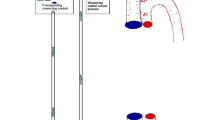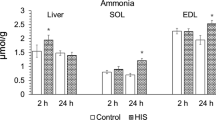Abstract
Excitatory amino acids have been implicated in the production of calcium mediated neuronal death following central nervous system ischemia. We have used microdialysis to investigate changes in the extracellular concentrations of amino acids in the spinal cord after aortic occlusion in the rabbit. Glutamate, aspartate, glutamine, asparagine, glycine, taurine, valine, and leucine were measured in the micordialysis perfusate by high pressure liquid chromatography. The concentrations of glutamate, glycine, and taurine were significantly higher during ischemia and reperfusion than controls. Delayed elevations in the concentrations of asparagine and valine were also detected. The elevation of glutamate is consistent with the hypothesis that excitotoxins may mediate neuronal damage in the ischemic spinal cord. Increased extracellular concentrations of asparagine and valine may reflect preferential use of amino acids for energy metabolism under ischemic conditions. The significance of increased concentrations of inhibitory amino acid neurotransmitters is unclear.
Similar content being viewed by others
References
Simon, R. P., Swan, J. H., Griffiths, T., and Meldrum, B. S. 1984. Blockade of N-Methyl-D-Aspartate receptors may protect against ischemic damage in the brain. Science 2216:850–852.
Faden, A. I. and Simon, R. P. 1988. A potential role for excitotoxins in the pathophysiology of spinal cord injury. Ann. Neurol. 23:623–626.
Choi, D. W. 1985. Glutamate neurotoxicity in cortical cell culture is calcium dependent. Neurosci. Lett. 58:293–297.
Wahl, P., Schousboe, A., Honore, T., and Drejer, J. 1989. Glutamate-induced increase in intracellular Ca2+ in cerebral cortex neurons is transient in immature cells but permanent in mature cells. J. Neurochem. 53:1316–1319.
Zanotto, L., and Heinemann, U. 1983. Aspartate and glutamate induced reductions in extracellular free calcium and sodium concentration in area CA1 of ‘in vitro’ hippocampal slices of rats. Neurosci. Lett. 35, 79–84.
Benveniste, H., Drejer, J., Schousboe, A., and Diemer, N. H. 1984. Elevation of the extracellular concentrations of glutamate and aspartate in rat hippocampus during transient cerebral ischemia monitored by intracerebral microdialysis. J. Neurochem. 43:1369–1374.
Butcher, S. P., Sandberg, M., Hagberg, H., and Hamberger, A. 1987. Cellular origins of endogenous amino acids released into the extracellular fluid of the rat striatum during severe insulin-induced hypoglycemia. J. Neurochem. 48:722–728.
Faden, A. I., Demediuk, P., Panter, S. S., and Vink, R. 1989. The role of excitatory amino acids and NMDA receptors in traumatic brain injury. Science 244:798–800.
Demediuk, P., Daly, M. P., and Faden, A. I. 1989. Effect of impact trauma on neurotransmitter and nonneurotransmitter amino acids in rat spinal cord. J. Neurochem. 52:1529–1536.
Brodin, E., Linderoth, B., Gaselius, B., and Ungerstedt, U. 1987.In vivo release of substance P in cat dorsal horn studied with microdialysis. Neurosci. Lett. 76:357–362.
Robertson, C. S., and Grossman, R. G. 1987. Protection against spinal cord ischemia wit insulin-induced hypoglycemia. J. Neurosurg. 67:739–744.
Skilling, S. R., Smullin, D. H., Beitz, A. J., and Larson, A. A. 1988. Extracellular amino acid concentrations in the dorsal spinal cord of freely moving rats following veratridine and nociceptive stimulation. J. Neurochem. 51:127–132.
Sorkin, L. S., Steinman, J. L., Hughes, M. G., Willis, W. D., and McAdoo, D. J. 1988. Microdialysis recovery of serotonin released in the spinal cord dorsal horn. J. Neurosci. Meth. 23:131–138.
Cheng, M. K., Robertson, C., Grossman, R. G., Foltz, R., and Williams, V. 1984. Neurological outcome correlated with spinal evoked potentials in a spinal cord ischemia model. J. Neurosurg. 60:786–795.
Simpson, R. K. Jr., Robertson, C. S., and Goodman, J. C. 1989. Alterations in the corticomotor evoked potential following spinal cord ischemia. J. Neurosci. Meth. 28:171–178.
Bidlingmeyer, B. A., Cohen, S. A., Tarvin, T. L. 1984. Rapid analysis of amino acids using pre-column derivatization. J. Chromatogr. 336:93–104.
Cohen, S. A., Bidlingmeyer, B. A., Tarvin, T. L. 1986. PITC derivatives in amino acid analysis. Nature 320:769–770.
Drejer, J., Benveniste, H., Diemer, N. H., and Schousboe, A. 1985. Cellular origin of ischemia-induced glutamate release from brain tissuein vivo andin vitro. J. Neurochem. 45:145–151.
Cooper, J. R., Bloom, F. E., and Roth, R. H. 1986. Pages 124–172,in The Biochemical Basis of Neuropharmacology, Oxford University Press, New York.
Hagberg, H., Lehmann, A., Sandberg, M., Nystrom, B., Jacobson, I., and Hamberger, A. 1985. Ischemia-induced sift of inhibitory and excitatory amino acids from intra- to extracellular compartments. J. Cereb. Blood Flow Metab. 5:413–419.
Faden, A. I., Lemke, M., Simon, R. P., and Noble, L. J. 1988. N-Methyl-D-Aspartate antagonist MK801 improves outcome following traumatic spinal cord injury in rats: Behavioral, anatomic, and neurochemical studies. J. Neurotrauma 5:33–45.
Panter, S. S., Yum, S. W., and Faden, A. I. 1990. Alteration in extracellular amino acids after traumatic spinal cord injury. Ann. Neurol. 27:96–99.
Benveniste, H. 1989. Brain microdialysis: short review. J. Neurochem. 52:1667–1679.
Fagg, G. E., and Foster, A. C. 1983. Amino acid neurotransmitters and their pathways in the mammalian central nervous system. Neuroscience 9:701–719.
Graham, L. T., Shank, R. P., Werman, R., and Aprison, M. H. 1967. Distribution of some synaptic transmitter suspects in cat spinal cord: glutamic acid, aspartic acid, γ-amino butyric acid, glycine, and glutamine. J. Neurochem. 14:465–472.
White, A., Handler, P., and Smith, E. L. 1973. Principles of Biochemistry, Pages 677–704, McGraw-Hill Book Company, New York.
Chizhmakov, I. V., Kiskin, N. I., Krishtal, O. A., and Tsyndrenko, A. Y. 1989. Glycine action on N-methy-D-aspartate receptors in rat hippocampal neurons. Neurosci. Lett. 99:131–136.
Larson, A. A. 1989. Intrathecal GABA, glycine, taurine or beta-alanine elicits dyskinetic movements in mice. Pharmacol. Biochem. Behav. 32:505–509.
Zeevalk, G. D., Hyndman, A. G., and Nicklas, W. J. 1989. Excitatory amino acid-induced toxicity in chick retina: amino acid release, histology, and effects of chloride channel blockers. J. Neurochem. 53, 1610–1619.
Padjen, A. L., Mitsoglou, G. M., and Hassessian, H. 1989. Further evidence in support of taurine as a mediator of synaptic transmission in the frog spinal cord. Brain Res. 488:288–296.
Oja, S. S., and Kontro, P. 1983. Taurine.in Pages 501–533, Lajtha, A., (ed), Handbook of Neurochemistry, Plenum Press, New York.
Lehmann, A., Hagberg, H., and Hamberger, A. 1984. A role for taurine in the maintenance of homeostasis in the central nervous system during hyperexcitation? Neurosci. Lett. 52:341–346.
Fariello, R. G., Golden, G. T., and Pisa, M. 1982. Homotaurine (3 aminopropanesulfonic acid; 3APS) protects from the convulsant and cytotoxic effect of systemically administered kainic acid. Neurology 32:241–245.
Author information
Authors and Affiliations
Rights and permissions
About this article
Cite this article
Simpson, R.K., Robertson, C.S. & Goodman, J.C. Spinal cord ischemia-induced elevation of amino acids: Extracellular measurement with microdialysis. Neurochem Res 15, 635–639 (1990). https://doi.org/10.1007/BF00973755
Accepted:
Issue Date:
DOI: https://doi.org/10.1007/BF00973755




